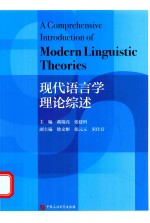图书介绍
现代语言学理论综述【2025|PDF|Epub|mobi|kindle电子书版本百度云盘下载】

- 戴瑞亮,张建科主编;徐文彬,张元元,宋佳音副主编 著
- 出版社: 东营:中国石油大学出版社
- ISBN:9787563654659
- 出版时间:2016
- 标注页数:191页
- 文件大小:26MB
- 文件页数:200页
- 主题词:语言学-理论研究
PDF下载
下载说明
现代语言学理论综述PDF格式电子书版下载
下载的文件为RAR压缩包。需要使用解压软件进行解压得到PDF格式图书。建议使用BT下载工具Free Download Manager进行下载,简称FDM(免费,没有广告,支持多平台)。本站资源全部打包为BT种子。所以需要使用专业的BT下载软件进行下载。如BitComet qBittorrent uTorrent等BT下载工具。迅雷目前由于本站不是热门资源。不推荐使用!后期资源热门了。安装了迅雷也可以迅雷进行下载!
(文件页数 要大于 标注页数,上中下等多册电子书除外)
注意:本站所有压缩包均有解压码: 点击下载压缩包解压工具
图书目录
Part Ⅰ Structuralism2
Chapter 1 Saussure:Father of Modern Linguistics2
1.1 Ferdinand de Saussure2
1.2 Nature of the linguistic sign2
1.3 The relational nature of language units3
1.4 Syntagmatic and paradigmatic relations4
1.5 Langue and parole6
1.6 Synchronic and diachronic studies7
1.7 Saussure's influence8
Chapter 2 American Structuralism11
2.1 Early period:Boas and Sapir12
2.1.1 Franz Boas12
2.1.2 Edward Sapir14
2.1.3 Linguistic relativity23
2.1.4 Linguistic relativity and cognitive linguistics25
2.2 Leonard Bloomfield29
2.2.1 Bloomfield the man30
2.2.2 Bloomfield and behaviorism30
2.2.3 Bloomfield and his Language33
2.2.4 Structuralism and language teaching37
2.3 Conclusion38
Part Ⅱ Functionalism40
Chapter 3 The Prague School40
3.1 Historical background41
3.2 Theories of language42
3.3 Phonology and phonological opposition46
3.4 Distinctive Features49
3.5 Functional Sentence Perspective(FSP)51
Chapter 4 The London School58
4.1 Malinowski's theories58
4.2 Firth's theories60
4.3 Halliday and Systemic-Functional Grammar62
4.3.1 Halliday's philosophy of language63
4.3.2 Systemic grammar65
4.3.3 Functional grammar68
4.3.4 Halliday and sociolinguistics74
Part Ⅲ Generativism83
Chapter 5 Transformational-Generative Grammar83
5.1 Chomsky's philosophy of language83
5.1.1 Background83
5.1.2 What is language?85
5.1.3 The Innateness Hypothesis86
5.1.4 Universal grammar and particular grammar87
5.1.5 What is a generative grammar?88
5.2 Stages of development of TG Grammar89
5.2.1 The Classical Theory89
5.2.2 The Standard Theory92
5.2.3 The Extended Standard Theory94
5.2.4 Later Theories96
5.3 A comparison between TG Grammar and structural grammar97
Part Ⅳ Cognitivism102
Cahpter 6 Metaphor and Metonymy102
6.1 Metaphor102
6.1.1 Metaphor in cognitive linguistics103
6.1.2 Features of metaphor107
6.1.3 The experiential basis of metaphor111
6.2 Metonymy112
6.3 Metaphor metonymy interaction118
Chapter 7 Image Schema and Polysemy120
7.1 Image schema120
7.1.1 Containment schema121
7.1.2 Path schema123
7.1.3 Force schema124
7.2 Polysemy126
7.2.1 Prepositions127
7.2.2 Modal verbs130
Chapter 8 Categorization and Idealized Cognitive Models133
8.1 Categorization133
8.1.1 The classical theory133
8.1.2 The prototype theory136
8.1.3 Levels of categorization139
8.2 Idealized cognitive models139
8.2.1 Characteristics of ICMs140
8.2.2 Typicality effects from ICMs141
Chapter 9 Iconicity150
9.1 Iconicity of order151
9.1.1 Temporal order151
9.1.2 Spatial order152
9.1.3 Culture-motivated order155
9.1.4 Word order related to asymmetry in cognition156
9.2 Iconicity of distance157
9.2.1 Causation157
9.2.2 Coordination158
9.2.3 Possession159
9.2.4 Negation159
9.2.5 Internal structure of word160
9.2.6 Multi-modifier construction160
9.2.7 Attributive clause161
9.2.8 Subjunctive mood162
9.3 Iconicity of quantity162
9.3.1 Word form163
9.3.2 Emphatic sentence163
9.3.3 Exclamatory sentence164
9.3.4 Sentence of politeness164
9.3.5 Other structures165
9.4 Philosophical interpretation of iconicity166
9.5 Iconicity and other competing principles168
9.5.1 Iconicity and economy168
9.5.2 Iconicity and pragmatic principles169
9.5.3 Iconicity and abstract syntactic conventions170
Chapter 10 Conceptual Blending172
10.1 The origins of Blending Theory173
10.2 Towards a theory of conceptual integration174
10.3 The nature of blending179
10.3.1 The elements of conceptual blending179
10.3.2 Further linguistic examples181
10.3.3 Non-linguistic examples183
10.4 Contrasting Blending Theory with Conceptual Metaphor Theory184
Bibliography187
热门推荐
- 47436.html
- 845418.html
- 2428023.html
- 1938883.html
- 3336388.html
- 3475429.html
- 3502050.html
- 3799035.html
- 239063.html
- 137377.html
- http://www.ickdjs.cc/book_3022298.html
- http://www.ickdjs.cc/book_274887.html
- http://www.ickdjs.cc/book_3733144.html
- http://www.ickdjs.cc/book_574966.html
- http://www.ickdjs.cc/book_3895756.html
- http://www.ickdjs.cc/book_3513946.html
- http://www.ickdjs.cc/book_1466166.html
- http://www.ickdjs.cc/book_2367317.html
- http://www.ickdjs.cc/book_2904343.html
- http://www.ickdjs.cc/book_1797923.html